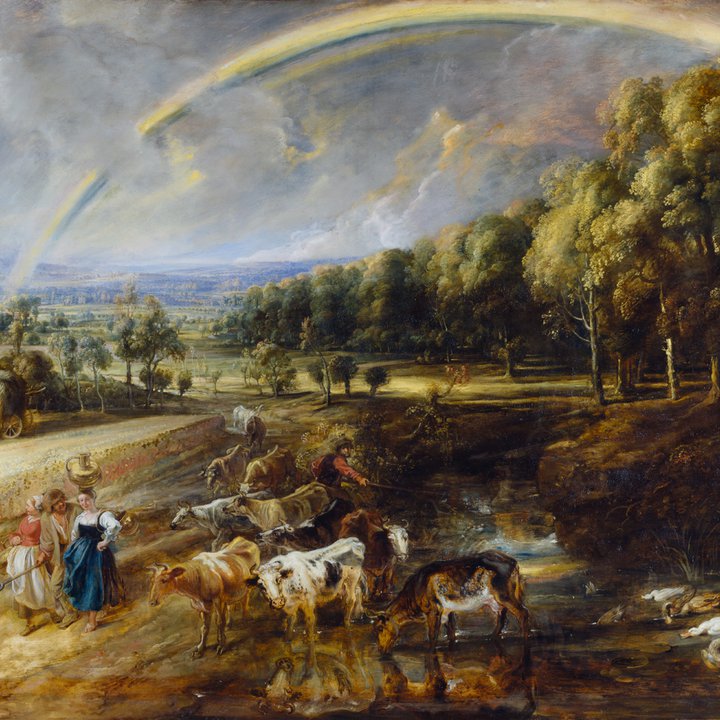In Focus: An Allegory of True Love
While The Rainbow Landscape is on display in our exhibition galleries for Rubens: Reuniting the Great Landscapes, our Flemish masterpiece An Allegory of True Love by Pieter Pourbus has its moment to shine in the centre of the hang in the Great Gallery.
Like Rubens’s, it is painted on a composite oak panel, but is rather simpler in construction, consisting of five horizontal boards rather than Rubens’s eighteen.
Pieter Pourbus was the founder of a dynasty of painters from Bruges. His son and grandson were both painters, the latter, Frans Pourbus (1569–1622), was, like Rubens, a court painter to both Duke Vincenzo Gonzaga of Mantua and the Archdukes Albert and Isabella of the Spanish Netherlands. There is another link to Rubens in the sense that this painting was once interpreted as a garden of love, a subject developed and explored by Rubens himself.
We are particularly fortunate to have such a unique painting in our collection. It is one of only two securely-attributed paintings by Pourbus in the national museums of this country —the other being a portrait in the National Galleries of Scotland. It is also the only remaining painting of a secular subject in the oeuvre of the artist, who otherwise specialised in Biblical subject matter and portraits.
According to an early biographer, Pieter Pourbus was a native of Gouda (in present-day Holland) who moved to Bruges at the age of about twenty. He must have been a fully-trained painter when he arrived, since he was admitted shortly afterwards to the Bruges painters’ guild. He was active in a number of guilds in the city, including the crossbowmen’s guild and one of the city’s two chambers of rhetoric (amateur literary confraternities). His involvement in this society of poets and musicians seems to have been key in the creation of our masterpiece.
An Allegory of True Love is dated to c. 1547 and is his earliest signed work (it is signed in black in the lower right ‘Petrus Pourbus Faciebat’). It was painted at a time when Pourbus was working under the protection of his father-in-law Lancelot Blondeel, and must have been important in establishing his name as the leading painter of Bruges until his death in January 1584.
In this intriguing image, a group of allegorical figures are gathered around an ornate dining table, a mensa voluptatis, that bears the food of love. They are nearly all named. At the centre are a couple —Wisdom (Sapiens) who embraces Fidelity (Fidutia)— who represent spiritual love or the sanctity of Christian marriage. Around them are famous male lovers from classical antiquity (Adonis, Acontius, and Daphnis) who are each accompanied by two female personifications of sensual and inconstant love (the Graces—Pasithea, Aglaia, Euphrosine; and Affectio, Cordialitas and Reverentia, respectively).
The contrast between the central couple and those around them is further emphasized through contrast in clothing and posture: Fidutia is chastely dressed in a high-necked dress and a crucifix, while the Graces are scantily clad in bright coloured fabrics; the pair who personify spiritual love sit upright while the lovers around them sprawl against one another. The low relief carving on the table represents personifications of sensuality. The jester reclining in the right foreground echoes the pose of the male lover opposite him and emphasises not only the theatricality of the scene but also perhaps the deceptive nature of appearance.
We do not know who commissioned this unusual painting. However, the Pourbus expert Paul Huvenne found parallels between its subject matter and an amorous refrein poem written by Edouard De Dene, a member of the chamber of rhetoric to which Pourbus also belonged. The sheet music on the table is the tenor part of a chanson first published in Antwerp in 1543.
An infrared reflectogram recorded in 2005 at the National Gallery reveals a detailed underdrawing of the entire composition, one of the most beautiful in Pourbus’s oeuvre. It is also visible under the paint layers.
Pourbus used underdrawing to set out the design of the composition on the primed support, and elaborated the forms and shadows with detailed hatchings. Revisions to the underdrawing show that he invested a lot of effort in getting all the details right. He then used the underdrawing as a guideline when applying his paint.
We intend to make this elaborate underdrawing the object of further study, but as we celebrate Rubens’s landscapes, we’ve chosen to focus on a detail from the beautiful decorative landscape background. Like Rubens’s Rainbow Landscape it belongs to the Flemish ‘world view’ tradition of landscape painting. Pourbus has delineated the farm buildings, gates, windmills and church spires with quickly drawn but accurate lines, while also freely drawing the foliage of the trees.


An Allegory of True Love was acquired by Sir Richard Wallace in 1872 for the relatively modest sum of £650. It was an enlightened purchase, given that it is universally recognised as a masterpiece, but little was known about the artist or the subject matter at the time of the purchase.
By Dr Lucy Davis, Curator of Flemish and British paintings, Wallace Collection, with Anne van Oosterwijk, Director of Collection, Musea Brugge.
For an analysis of Pourbus’s working methods, including his use of the underdrawing, see Anne van Oosterwijk, ed., Forgotten Masters. Pieter Pourbus and Bruges Painting from 1525 to 1625, exh. cat., Groeningemuseum Bruges, 2017.




